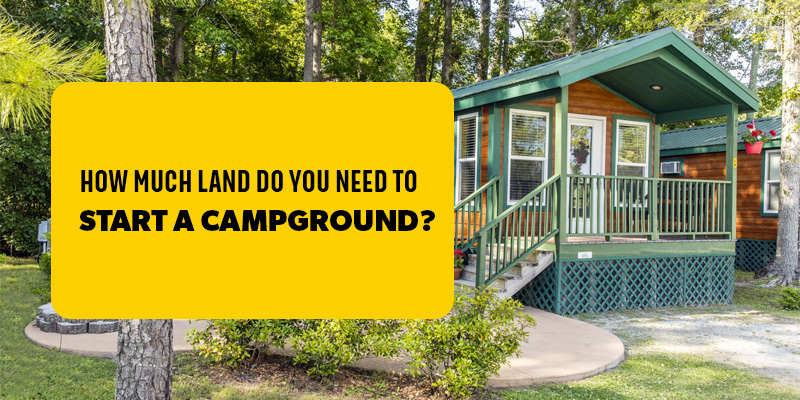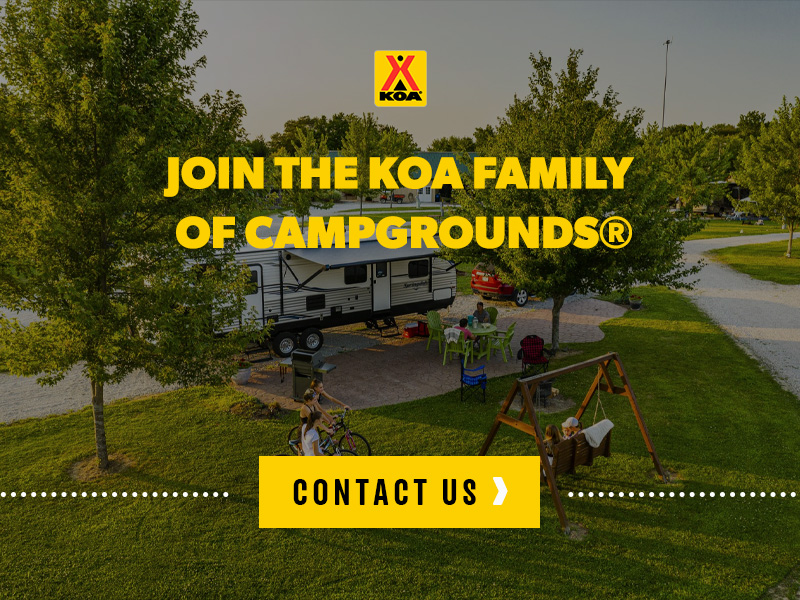
Starting a campground is an exciting and promising venture. Etching out a spot for yourself in the thriving camping industry will require strategic planning and informed decisions. Whether opening an RV or multiuse campground, start the process by ensuring you have plenty of space for your guests, amenities and facilities.
This article will discuss how many acres you need for a campground and how to lay the foundation for a successful business. When you work with Kampgrounds of America, Inc., to open your campground, you gain access to more than 60 years of experience. KOA is more than a consultant — we are a partner.
Need help determining your land requirements? Call 406-709-3536 to talk with a KOA advisor!
Land Size Requirements for Different Campground Types
The average acreage of campgrounds in the United States depends on the type of campground and its location. However, a good general rule is to have at least one acre of land per 10 sites on your campground.
This means smaller campgrounds with fewer than 50 campsites will need at least five acres, medium-sized campgrounds should have at least 10 acres, and more than 15 acres are necessary for large campgrounds. Land size requirements can also depend on whether you plan on opening an RV or multiuse campground:
- RV campgrounds: Around five to 10 acres is enough for small- to medium-sized RV campgrounds. Larger operations would benefit from having at least 15 acres. This provides enough room for larger vehicles, hookups and amenities.
- Mixed-use campgrounds: If you plan to accommodate RVs, tents and cabins, you will likely need at least 20 acres to fit each lodging option while leaving room for amenities and facilities.
Remember that these are just recommendations. Assessing your available land gives you a higher chance of thriving in a competitive market. By making informed choices during the planning process and working with a well-known campground franchise like KOA, your business can stand out in the vibrant outdoor hospitality industry.
Factors Influencing Campground Land Requirements
Consider these factors when determining the amount of space you will need for your campground.
Regulatory Requirements
It is essential to understand the regulations and zoning laws that will impact your business and the land. These provisions will help you structure your land efficiently, specify activities allowed in different locales and determine how much land you need for your campground.
Zone laws stipulate the uses required for land depending on the area. For instance, some areas must be reserved for agricultural activities, others prioritize residential developments, and some are meant for commercial enterprises. Understanding zoning laws in your area can help you find the best place for your campground. If the land does not have zoning laws, you will still have to adhere to construction laws in your state and county when building the campground.
You must also create buffer zones between your campground and neighboring properties. Be sure to understand your regulatory landscape, consult with local authorities and ask for help from experts in the field. That way, you can decide how many acres you must purchase for a campground.
Site Layout

Consider your campground layout when determining the amount of land you will need:
- RV campground: Factor in Pull-Thru or Back-In sites when considering the land needed for an RV campground. Also, consider space for utility hookups. Placing sites in a grid layout and angling them toward the road is an efficient way to use space, and it makes parking easy for guests.
- Cabins: While cabin sizes vary, you need additional space for parking, walkways and privacy buffers. Clustering cabins in one area can optimize land use compared to spreading them out.
- Open green areas: Consider the amount of land you will need for green spaces, which includes open areas for relaxation, recreation and aesthetic appeal.
Carefully designing your campground layout to accommodate these elements can help you optimize land use and meet guest needs.
Amenities and Facilities
Consider the amenities and facilities you will include when determining campground land size. These amenities enhance the experience for visitors, and they also contribute to your campground’s aesthetics and functionality:
- Utility hookups: For RV campgrounds, provide space for utility hookups, including water, electricity and sewage systems.
- Bathing and laundry facilities: Add convenience and comfort by including well-maintained restrooms and laundry rooms, considering drainage and plumbing.
- Recreation: Include recreation spaces, such as barbeque pits, playgrounds, pools and picnic areas. These spaces will become the hub of social activities, establishing community among your campers.
- Retail space: Consider allotting space for a shop where campers can stock up on essential supplies and souvenirs.
Properly planning your facilities will impact your layout and land requirements when starting a campground, steering you toward success.
Topography and Location
Consider the impact of terrain and surroundings on land usability. Features can include:
- Vegetation and wildlife: Consider protected natural areas and potential restrictions on development — this can influence the amount of land available. You might also need to set aside land for conservation purposes.
- Proximity to amenities: Campgrounds near popular attractions or towns may need less land for on-site amenities, as they can rely on nearby facilities instead.
- Terrain: Campgrounds on hilly or mountainous terrain may require more land to accommodate access roads, terraced campsites and other features. Flat terrain might offer more efficient land use. Still, you should consider grading and drainage requirements.
- Water: If you start a campground near a lake, river or ocean, you will likely require more space for waterfront access and activities.
How to Optimize Land Use
Make the most of your available campground land with the following strategies:
- Efficient site planning: When planning your campground layout, group similar sites together to minimize wasted space. Consider using natural features to enhance your campground’s appeal while saving landscaping costs.
- Multiuse spaces: Make optimal use of space with versatile areas. This might include using a common room as a dining space and event venue. You can also structure outdoor areas for yoga in the morning and movies at night.
- Compact infrastructure: Consider space-saving designs for storage areas and utilities to free up land for recreational use. Plan your roads and pathways for optimal traffic flow and visitor access through the campground.
- Sustainable design: Implement eco-friendly practices, such as energy-efficient lights and water-conserving faucets, to reduce your environmental impact.
Join the KOA Family of Campgrounds®
Designing an efficient campground that optimizes land can help you thrive in the outdoor hospitality market. Being a part of KOA makes starting your business easier. With more than 500 locations across North America, KOA can help you determine the suitable land and space requirements for your campground business goals.
KOA offers plenty of resources and advice on running a campground. To learn more about the advantages of becoming a KOA franchisee, fill out an information request form today!
